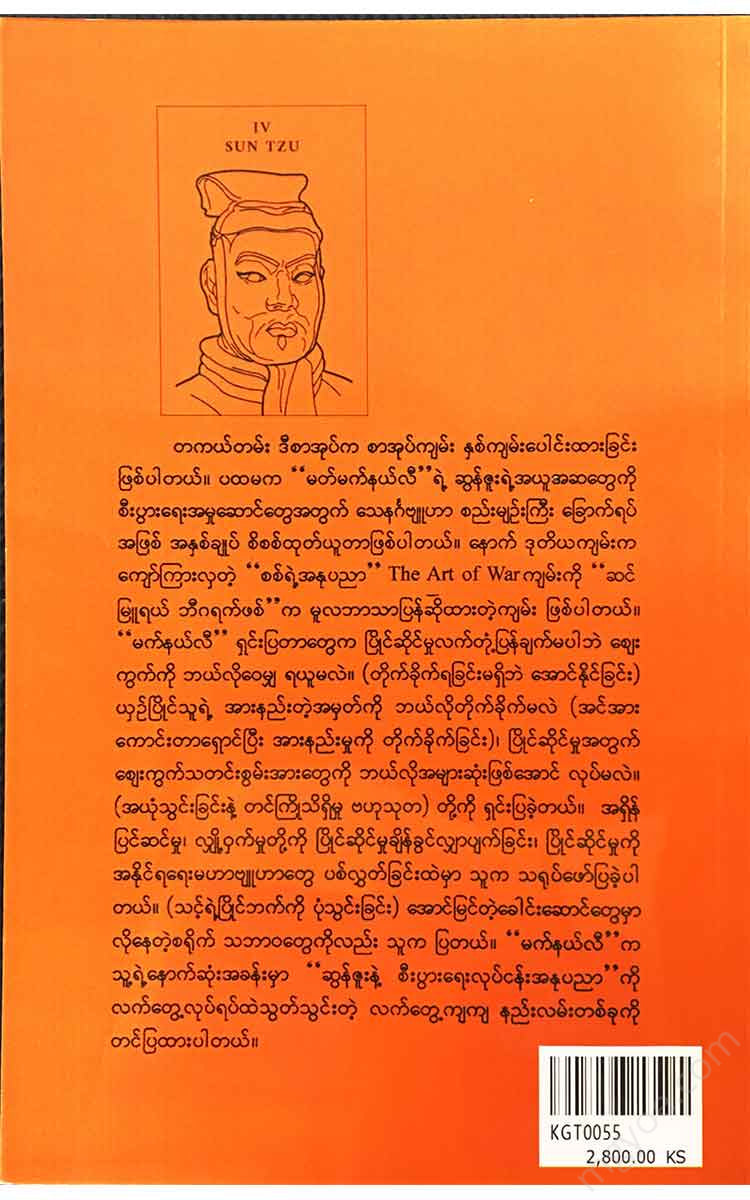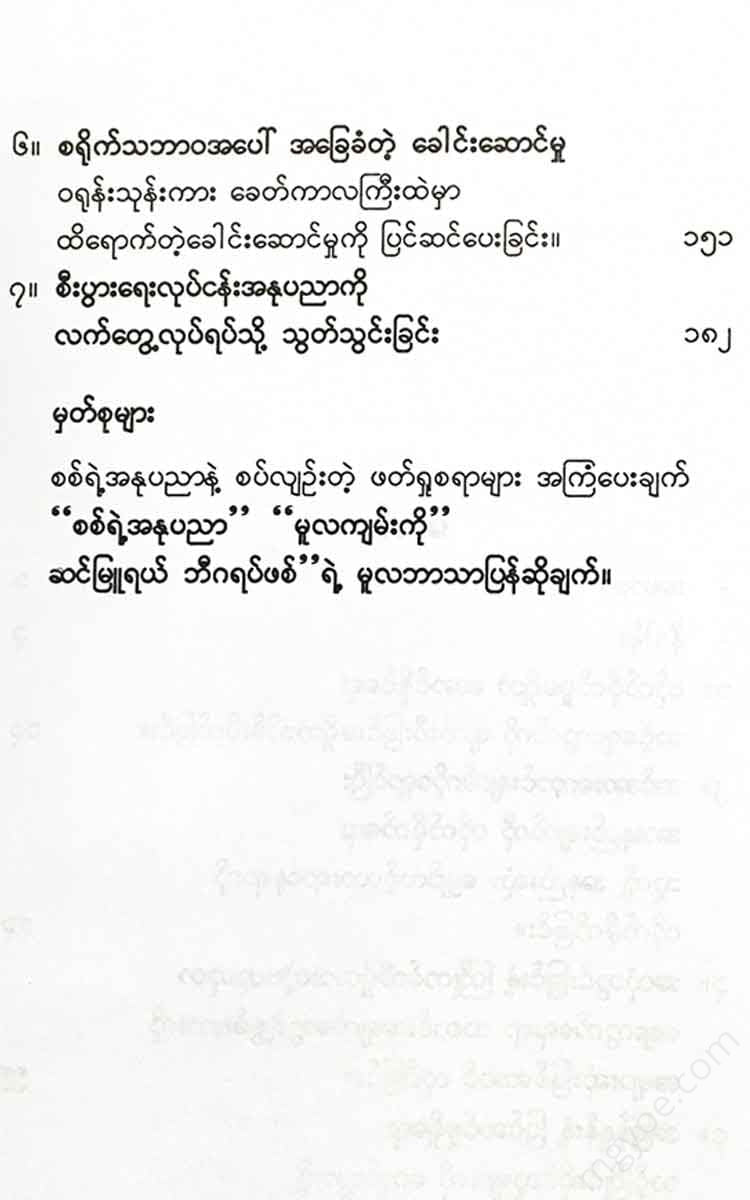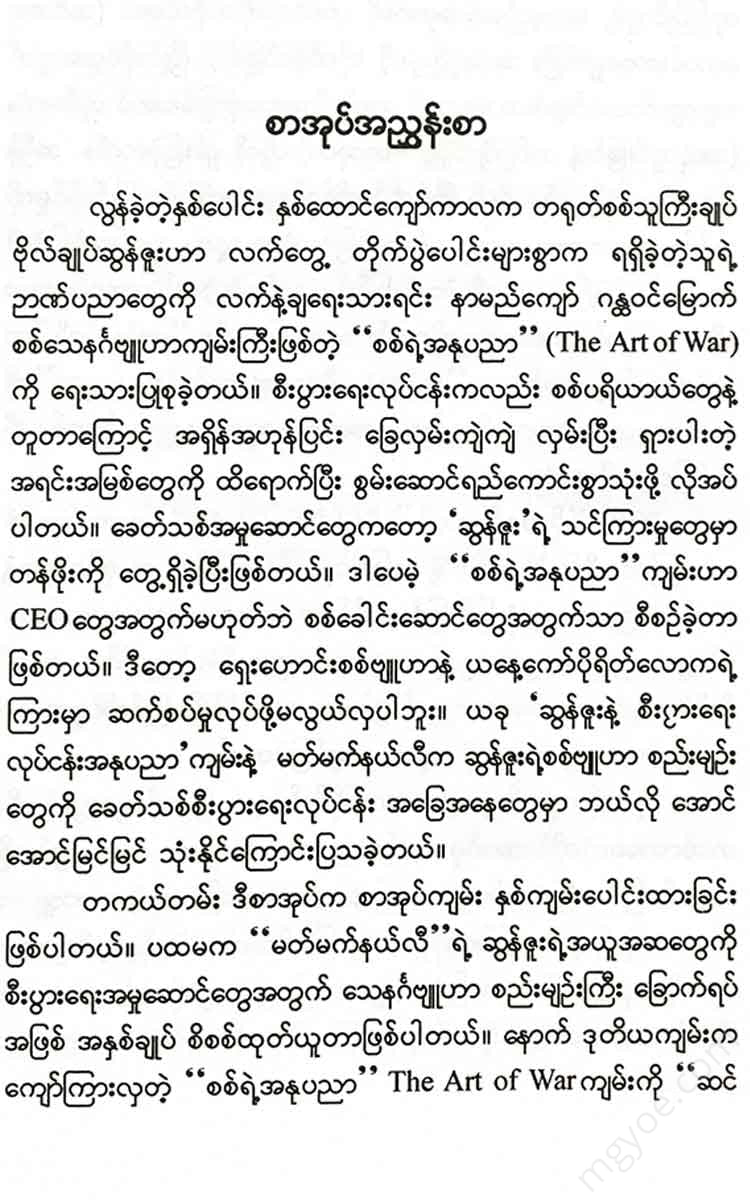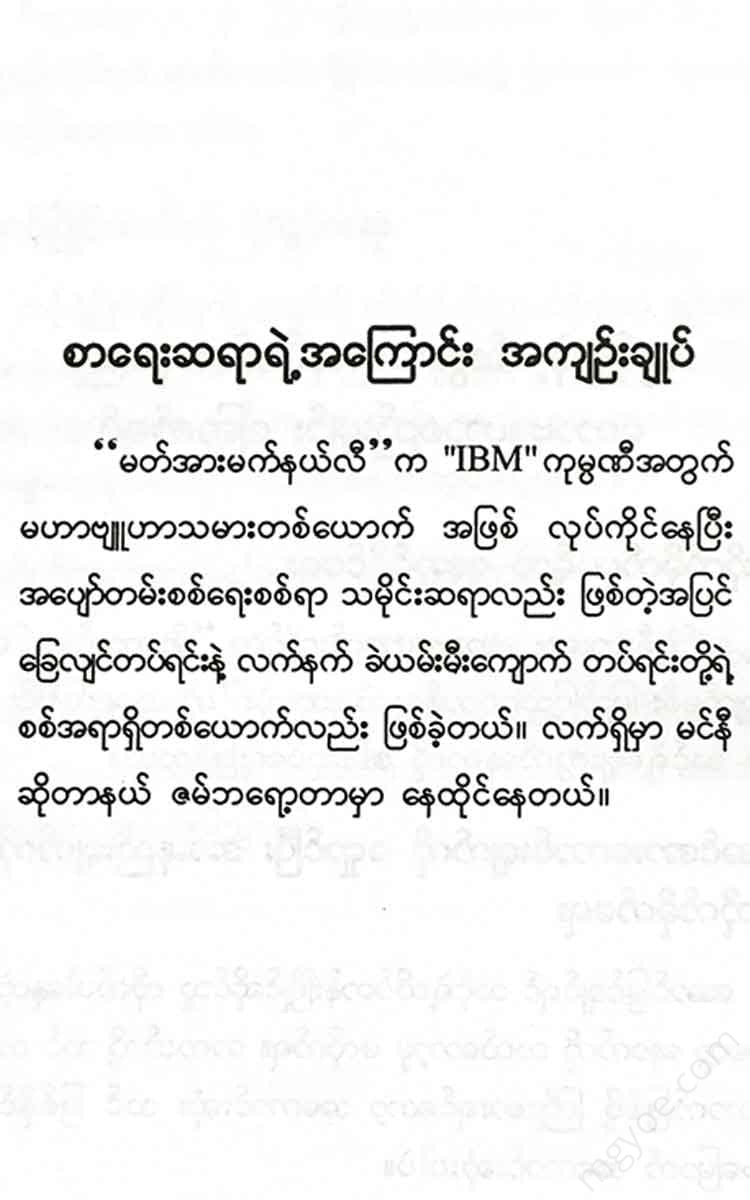စိတ်ကူးချိုချိုစာပေ
Good - Sun Tzu and the Art of Business
Good - Sun Tzu and the Art of Business
Couldn't load pickup availability
Sun Tzu and the Six Principles of Business Strategy
1. Victory without attack
Your business strategy goal is to capture “everything under the sky that is still intact and full” and capture your market share without losing it.
2. Avoiding strengths and attacking weaknesses
If you want to be successful, never follow the strategies your top competitors are following. If you try to be someone else, the best you can be is second best.
3. Trust and prior knowledge
If you want to beat the competition, you have to know your competitors. You have to know your company. You have to know your market niche.
4. Speed and preparation
The nature of business competition is change. Its pace is to keep up. Slowing down is to die out.
5. Shaping your opponent
You must use both direct and indirect approaches to shape your competition. You must leverage alliances to limit your competitors' movements and capitalize on the motivations of their executives.
6. Character-based leadership
You have to lead by example. You have to understand your people and share their good and bad times. Say what's important and then follow through.
Sun Tzu and the Art of Business
All praise is due to
If only the past CEOs of "K-Mart," "ATRT," "Xerax," "General Motors," and their companies had read this book, they would have saved themselves billions of dollars.
"Philip Kotler" JL Kellogg graduate
School Administration, Northwestern University.
- “This practical introduction to Sun Tzu's ideas
Helping American business leaders quickly gain an edge over their international competitors. Using Sun Tzu's wisdom, they began to wonder. Mr. McNally is the American business leader.
He deserves the world's gratitude. His new book is the fourth best American effort in the difficult task of transforming the great military strategy book known in the West as "Sun Tzu's The Art of War" into a useful guide for strategic managers.
David Ardenberg
Writings of Strategy and Leadership
“This book is fun, insightful, and a quick read. I highly recommend it to anyone interested in strategy.”
"The Academy of Management Executives" If you've always felt like doing business is like war, this new business textbook based on the teachings of an ancient Chinese general has a lot to offer.
"Entrepreneur" magazine. "Finally, someone has made a book called "The Art of War" complete."
"Kow"
"Brian Bloom" Chief of Operations.
"The C/W Company"
Check out the Sun Tzu Strategy Website.
Introduction
Around 400 BC, China was a time when warlords ruled over separate states. During this time, Sun Tzu, a general from the state of Qi, won many battles and became famous for his military power.
Drawing on his years of combat experience and practical wisdom, Sun Tzu compiled a book called "The Art of War," which is still widely known today as the classic Chinese military strategy. His book, which detailed a philosophy of how to decisively defeat one's opponent, has guided the military theories of generals in both the East and the West for centuries. "The Art of War" contains not only Sun Tzu's insights but also further explanations by his successors, Li Chung-ma and Tu Mu, and other military thinkers. The aggressive strategic approach that military readers found in "The Art of War" is not only powerful, but also concise and easy to understand, making it a true classic of military strategy.
How to use the art of war
The first emperor of China, Qin Shi Huang, studied the Art of War. He used its principles to unite China for the first time around 200 BC. 21st century CE, Mao Zedong used Sun Tzu’s writings to defeat Chiang Kai-shek and the Nationalists in 1949. China was unified as a communist state. Sun Tzu also influenced Mao Zedong’s guerrilla warfare strategies, which he transformed into strategies that spread communist insurgencies from Southeast Asia to Africa and the United States.
Japan was introduced to Sun Tzu's writings in 760 AD, and its generals absorbed his teachings. The three most famous samurai warriors were Oda Nobuo, Toyotomi Hideyoshi, and Tokugawa Ieyasu. They were all masters of the "art of war." The possession of this book as a teacher transformed Japan from a scattered feudal state into a unified nation.
In the West, The Art of War first appeared in Europe in 1772. It was translated into French by the "Sou" religious missions. Napoleon also read the book and was apparently influenced by Sun Tzu's works. He was a Chinese scholar and a scholar of Chinese literature.
He was interested not only in culture but also in all military matters.
British military historian B. H. Liddell Hart's theories on military strategy and the development of German rapid-fire warfare were based on his "deep admiration for the depth of Sun Tzu's military ideas and instructions." He was also struck by how much Sun Tzu's ideas reflected his own strategic theories and ideas. "The Art of War was widely read and accepted by the generals of the First World War, and helped them avoid the horrific slaughter of trench warfare."
The principles discussed in “The Art of War” have been used successfully in countless battles throughout history. The concept of speed played a vital role in Genghis Khan and his Mongol hordes’ victories. The Allies used camouflage to keep their enemies in check, and the Romans used camouflage to maintain and expand their empire. Secrecy and deception were used by both the Japanese and the Allies in major battles of World War II. The Japanese used them when they bombed Pearl Harbor, and the Allies used them when the Germans invaded France.
The Allies were misled by the positioning of the enemy. Only the use of intelligence could have allowed the Americans to succeed in the Cuban Missile Crisis. The Vietnamese survived by avoiding the enemy's strengths and using their weaknesses as a strategy of attack. The Russian Red Army also used this strategy to crush the entire 6th German fascist battalion at Stalingrad.
Sun Tzu's principles were recently put to the test in the Iraq War, Desert Storm. The US air force controlled the movement of Iraqi forces and concealed the movement of its own ground forces. US General H. Norman Schwarzkopf fooled Saddam Hussein about where his forces would attack. He threatened to advance slowly on the eastern front while he fought a lightning-fast campaign on the western front, and he won. The victory was won with great success, with very little loss. Deception, speed, and attacking the enemy's weaknesses were all Sun Tzu's ideas, and they were spectacular.
Unite to victory.
The art of war in the business world
Today, Sun Tzu's advice has expanded beyond the realm of military warfare to the world of business. Since the definition of business is related to competition, Sun Tzu's principles are ideally suited to competitive economic conditions. In the United States and Europe, “The Art of War” is cited in many strategic organizations and competitions. Its more striking references are cited in countless business articles. The famous movie “Wall Street ,” a story of corporate conglomerates and hostile takeovers, is about a battle of economic wits between the villainous “Gordon Gecko” and the young hero “Buffalo.” Throughout Asia, Sun Tzu’s strategic principles were revered and used by many CEOs to lead their companies to prosperity. Like military strategy, business is a contest of decisiveness, speed, and agility, based on both morality and machinery, and on the efficient use of scarce resources.
Because both are timeless and constantly changing, many businesspeople around the world find value in Sun Tzu's teachings.
Unfortunately, for many who have studied Sun Tzu's strategic philosophy, it is not a simple task to read this book directly and apply its military writings to today's economic problems. The "Art of War" is organized according to military topics, and there is a great gap between this ancient military strategy book and today's economic arena.
Jumping off a cliff is not easy. Many people who would attempt it find the task daunting. This
That is why I have written this book, "Sun Tzu and the Art of Business," to build a more direct bridge between Sun Tzu's ancient wisdom and today's business world.
This book explores Sun Tzu's writings to further expose his aggressive, multifaceted perspective on competitive strategy and its relevance to today's business world.
It is presented as a practical, more readable approach to the world. My hope is that people will be able to incorporate the principles in this book into strategies to make their companies more competitive. This is important to me for two reasons.
The first reason is that more creative competition can make shareholders richer and provide customers with better products and services at lower prices within the company.
Because. Also, a competitive strategy doesn’t necessarily mean that a company is taking a piece of the pie from another company. A creative strategy is more likely to lead to a bigger pie. Burger King has had to completely reinvent itself since 1993. It has improved its products and services and has become more competitive. McDonald’s has been improving itself by offering more choices with value food. “Wendy’s has done a lightning-fast operation that brought in its founder, David Thomas. When Procter & Gamble’s pain reliever ‘Aleve’ was launched, its advertising campaign and its competitors bought up the drug in droves.
On a global scale, when competition within a country requires the most creativity and demand, companies in that market tend to achieve greater success in other markets. The smarter the competition in the marketplace, the better the chances of companies surviving and prospering, and in essence, the better the standard of living by creating competition.
The second reason is that by applying Sun Tzu's principles, competition becomes more creative and business leaders can avoid the tedious strategic thinking that can lead to huge corporate losses. Millions of soldiers died and were wounded in World War I because their generals lacked strategic insight. Similar tragedies occurred within corporations during World War I. Many corporations collapsed, negatively affecting the lives of millions of people. This is because business leaders lacked strategic vision. The principles in this book can be widely applied by managers and executives to avoid corporate losses in the future. Business and Military Model
In the era of “flat” organizations, some questions arise about how a strategic alliance can be used in today's economy. Articles presenting military-style models are quite outdated.
| In fact, business strategy first emerged as military strategy. You can see how closely related ancient and modern military organizations are. Today's companies are only just beginning to understand how strategies are successfully implemented. Since the Chinese warlords used infantry and cavalry to fight together, business has been a part of military organizations and teams.
They have succeeded in overcoming the problems of action. Military leaders since the time of Xenaphon’s Persian expedition have wisely balanced discipline with power and control. Since the Napoleonic era, large armies have been able to accurately determine when and where to march to their destinations. Generals have been able to communicate with large numbers of men over long distances without interruption. Since the American Civil War, military officers have been able to use new technologies to advance and implement the Industrial Revolution to their advantage.
The judges who explained the application of military strategies to business were market experts such as "Felix Cotillard," "Thursday," and "Jet Trac," who have written numerous books and articles. Recently, "New Ideas from the Military"
The article is about this. "Moving Mountains: Logic and Leadership Lessons from the Gulf War" is a book by Lieutenant General William Pergonis, a teacher from his Persian Gulf War.
What has been achieved should be read as a model of military strategy. The six principles and the plan of this book
To transform Sun Tzu's "Art of War" into "Sun Tzu and the Art of Business," I have extracted the most important and, in my opinion, most reliable principles of Sun Tzu's strategy and divided them into the following sections. These principles are: 1. Conquer without attack;
Conquer your market without destroying it. 2. Avoid strengths and attack weaknesses.
Attack where they least expect it. 3. “Inspiration and prior knowledge”
Maximizing the power of market news. 4. “Speed and preparation”
Moving quickly to outpace your competitors. 5. “Shaping your competitors”
Strategy to dominate the competition.
6. “Character-Based Leadership” (Effective Leadership in Turbulent Times)
Giving.
Each chapter provides examples of how these principles are applied in the real business world, with examples of companies that have used them effectively.
The final chapter illustrates how these principles are translated into practical action. Sun Tzu's Timeless
A systematic approach to creative and winning strategies based on timeless ideas. To complete this book, the original English translation of Sun Tzu's The Art of War, along with the translation by "Simular Biographer" as the second part, is attached. Ethics and the Art of War
While the business world can learn a lot from war strategies, business people should not follow the destructive philosophies that all wars create. Business should be conducted ethically.
The British East India Company, with its own army and navy, had been occupying India and Asia for over 40 years, and had been ruled by its own civil servants. The rest of the world was left behind by the exploitation of the foreign peoples by this colonialist empire. The days of American bandits exploiting railways, steel and timber are over. The time has come for the people to work together to make a living.















